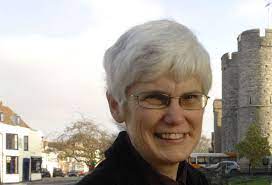
Dr Sheila Sweetinburgh
About
About
Dr Sheila Sweetinburgh is a late medieval social and cultural historian. Adopting a microhistory approach, she studies the rich documentary and material culture evidence surviving for Kent across a range of themes to investigate, most recently, the movement of people, goods and ideas in this ‘gateway county’. She is based in the Centre for Medieval and Early Modern Studies (MEMS), where she is a Specialist Associate Lecturer. She has been lecturing at the University of Kent since 1999 and has also worked as a researcher and lecturer at the University of Huddersfield and Canterbury Christ Church University.
Research interests
Sheila’s research focuses on medieval and Tudor Kent concerning the lives of those below the aristocracy and chronologically from the Black Death (although occasionally from the Norman Conquest) to the Reformation. Her interest in Kent stems from it being a county of numerous small/medium-sized towns, many belonging to the Cinque Ports confederation that were producing written records from an early date. Furthermore, the county benefitted from the employment of innovative agrarian techniques and the movement of people within Kent and more widely offers considerable scope for research due to the wide range of surviving evidence in the archives, as well as standing buildings and the landscape itself.
Having completed all her degrees at the University of Kent, she has been able to build up a considerable knowledge of the county’s history and heritage from her first book on The Role of the Hospital in Medieval England, to editing or co-editing a further four books, including Maritime Kent through the Ages, as well as publishing numerous articles on medieval urban society and agrarian society in the Middle Ages.
Sheila has worked on several funded projects including two for English Heritage: the development of medieval Lydd and its surroundings, and on the development of Sandwich c.900–1600, as well as two Leverhulme-funded projects: the production of an edited volume of Lady Anne Clifford’s ‘Great Books of Record’, and on the Gough Map project, which is nearing completion. Recently, as the Co-Investigator of the funded ‘Kent’s Maritime Communities’ project with colleagues from the University of Southampton, the team has published Kent and Europe 1450–1640: Merchants, Mariners, Shipping and Defence (2025).
Teaching and supervision
Having previous taught for the Schools of History and English Literature at undergraduate level at Kent, Sheila currently contributes to a postgraduate option module in MEMS, as well as supervising seven PhD students working on Kent history topics.
Professional
Sheila is a Trustee for the following charities and organisations: Brook Rural Museum, Eastbridge Hospital in Canterbury, The Oxus Foundation and CAMEMS, having previously been a Trustee and Vice President of the Kent Archaeological Society.
Select publications
The Role of the Hospital in Medieval England: Gift-giving and the Spiritual Economy (2004).
Edited volumes:
with S. Bligh and E. Edwards, Maritime Kent through the Ages: Gateway to the Sea (2020).
Early Medieval Kent, 800–1220, Kent History series (2016).
Negotiating the Political in Northern European Urban Society c.1400–1600 (2013).
Later Medieval Kent, c.1220–1540, Kent History series (2010).
Articles and book chapters:
‘Crossing the Channel: immigrant artisans and traders in fifteenth-century Canterbury’, in E. Edwards and D. Killingray, eds, Migration in Kent through the Ages (forthcoming, 2026).
‘Late Medieval Kent, c.1450–c.1550’, in R. Blackmore and C. Lambert, eds, Kent and Europe, 1450–1640: Merchants, Mariners, Shipping and Defence (2025), pp. 11–43.
‘The St Nicholas’ Hospital mazer and St Thomas Becket: from ‘everyday’ object to relic’, Archaeologia Cantiana 146 (2025), 92–110.
‘Neighbours across the religious divide: coping with difference in Henrician Kent’, in B. Kane and S. Sandall, eds, The Experience of Neighbourhood in Medieval and Early Modern Europe (2022), pp. 63–77.
‘More continuity than change: almshouses in Tudor Kent’, Southern History 42 (2020/21), 21–45.
‘“Ready for to go to sea”: maintaining fishing families in late medieval Hythe’, in S. Bligh, E. Edwards and S. Sweetinburgh, eds, Maritime Kent through the Ages (2020), pp. 387–400.
‘Fishermen and their families in late medieval and Tudor Kent’, in C. Jowitt, C. Lambert and S. Mentz, eds, The Routledge Research Companion to Marine and Maritime Worlds, 1400-1800: Oceans in Global History and Culture (2020), pp. 202–20.
‘Writing the town in mid-fifteenth-century Sandwich: the contribution of John Serle, common clerk’, in C. Bartram, ed., Book Culture in Provincial Communities: Contexts for Reading and Writing 1450-1650 (2020), pp. 49–72.
‘Religious women in the landscape: their roles in medieval Canterbury and its hinterland’, in V. Blud, D. Heath and E. Klafter, eds, Gender in Medieval Places, Spaces and Thresholds (2019), pp. 8–24.
‘Those who marched with Faunt: reconstructing the Canterbury rebels of 1471’, Southern History 39 (2017), 36–57.
‘Farming the Kentish marshlands: continuity and change in the late Middle Ages’, in J.P. Bowen and A. Brown, eds, Custom and Commercialisation in English Rural Society, c.1350–c.1750: Revisiting Postan and Tawney (2016), pp. 73–95.